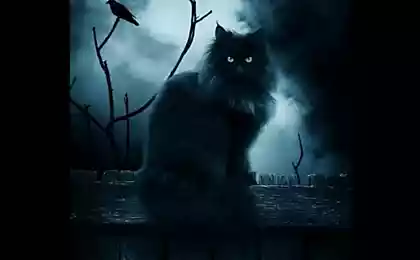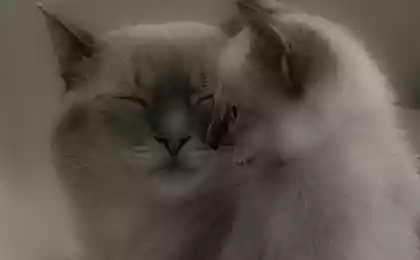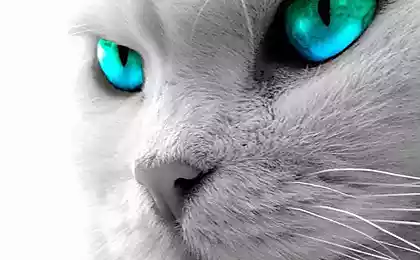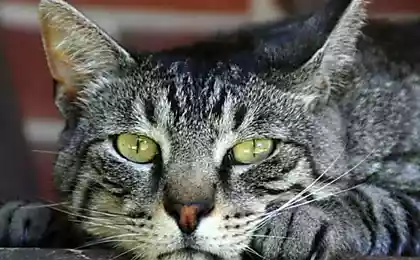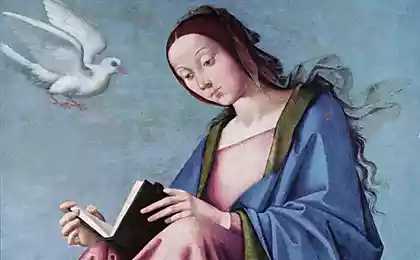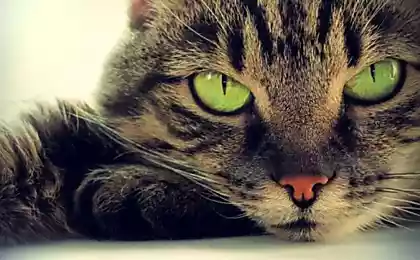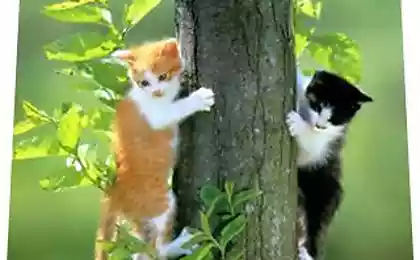1165
Cats medieval and Renaissance
Stories that in the Middle Ages cats are creatures bogomerzkih and offspring of the devil - no more than one of the popular myths about the Dark Ages. Cats in Europe brought more Greeks and Romans settled them throughout the empire existed in Celtic-Germanic West and the wild cat population. Another thing that kept cats as myshelovnyh animals except in the richest monasteries and religious communities with strong traditions in the villages with deratization copes ferrets and weasels.
And so the cat appears as a character in the puzzle Aldhelma in fables Eugene and Alcuin (where, quite funny, replaces the traditional wolf), cat Pangur Bán catches mice in the cell of the Irish monk who, looking at the cat is distracted from the divine, that in the fields of parchment write that they have similar problems with the cat: to catch mice to catch the words. Welsh laws tenth century evaluate the cat, which "sees, hears, catches mice retained all claws and feed the kittens, do not devour them," four pence.
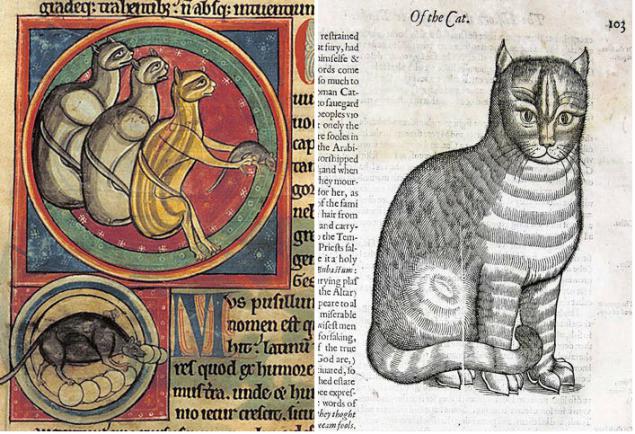
Black time to cats, especially black, begins in 1233, when Pope Gregory IX issues a message Vox in Rama, addressed to the archbishop of Mainz, Bishop of Hildesheim and Conrad of Marburg. The message, in fact, was directed against the Cathars and the cats got under the hand, because it is in the form of "black cat the size of a medium dog" Cathars allegedly was the devil. Was he to them in the form of a large toad, a goat and some birds ... in short, the usual propaganda of the time of excision marginal Christian denominations, a standard set of horrors perpetrated by heretics, including kissing the animals in the shameful parts and svalny sin after a meal, when zaduyut candles, dear Casaubon I remember with honey and pepper. Catch the cats, cats burn - you will receive a plague across Europe in a hundred years, no epidemiological training.
Only, I'm sorry, what is it the Middle Ages? This is the decline of high Gothic, to the "Divine Comedy" is less than a hundred years remains.
One of the earliest images of cats in European manuscripts, about 1170. English bestiary.

Another thing that cats have scribes and artists of the Middle Ages is not in the tradition, a skill passed on from teacher to student, dragons and griffins somewhat more real to the medieval mind than cats prowl the barn in the three-minute walk from the scriptorium. To explain the small number of hand-drawn cats in that they are associated with evil spirits, at least strange, given the abundance of snakes, toads, hoopoes, goats and own features in the fields of medieval books and jewelry letters.
However, medieval science cat forgets. In Isidore of Seville in the "Etymologies", this VII century, is considered the origin of the two names of animals: musio, because it catches mice, mus, and cattus, from captare, catch. By far my favorite of Bartholomew English in the eighteenth book work "On the properties of things" also wrote about cats: & quot; ... a beast in his youth raunchy, fast, funny and clever, playful, jumping on everything in front of him, running at straws, etc. . & quot; - Repeating, unfortunately, a sad misconception about the safety of the cats fall from any height.
Kisya of manuscripts, including "Herbarium" Pseudo-Apuleius, De herbis femininis Pseudo-Dioscorides and De medicina ex animalibus Sextus Platsita. England or France, last quarter of the XII century.
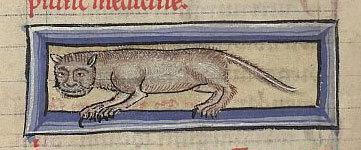
Aberdeen Bestiary, on the golden background and the way paint is visible at once. England line XII-XIII centuries.

Cat of the British bestiary middle of the XIII century. Good for you, rat caught.

England, XIV century.
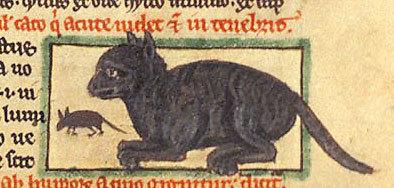
Again England, XV century.

With the ball. France, the middle of the XV century.

Next came marginalia and letters

Several traditional English ornamental letter with okolokoshachimi animals

11

12
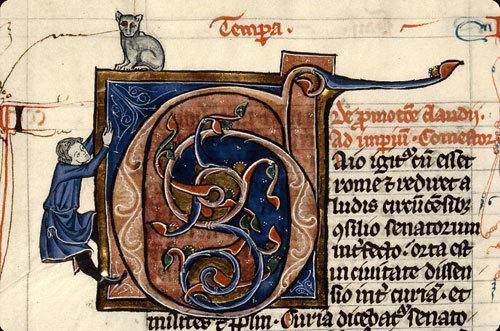
13 sad and instructive, something like "the wolf catches - and catch the wolf."

14

15

16

17

18

19
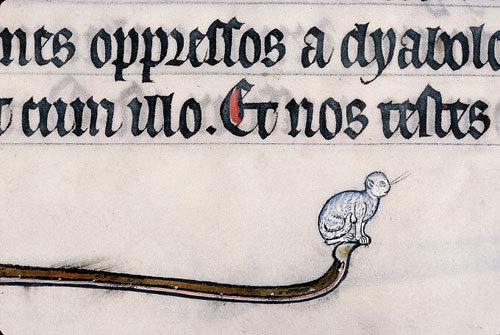
20
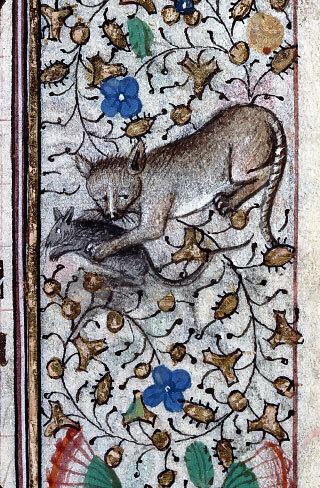
21

Luttrell Psalter

Merry company among the notes.

Monk goes about his business and cats, as has been said, does not notice, but the cat then somehow even more real than him.

25

26 here
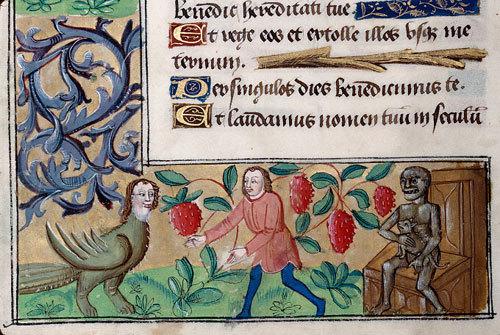
Source:
And so the cat appears as a character in the puzzle Aldhelma in fables Eugene and Alcuin (where, quite funny, replaces the traditional wolf), cat Pangur Bán catches mice in the cell of the Irish monk who, looking at the cat is distracted from the divine, that in the fields of parchment write that they have similar problems with the cat: to catch mice to catch the words. Welsh laws tenth century evaluate the cat, which "sees, hears, catches mice retained all claws and feed the kittens, do not devour them," four pence.

Black time to cats, especially black, begins in 1233, when Pope Gregory IX issues a message Vox in Rama, addressed to the archbishop of Mainz, Bishop of Hildesheim and Conrad of Marburg. The message, in fact, was directed against the Cathars and the cats got under the hand, because it is in the form of "black cat the size of a medium dog" Cathars allegedly was the devil. Was he to them in the form of a large toad, a goat and some birds ... in short, the usual propaganda of the time of excision marginal Christian denominations, a standard set of horrors perpetrated by heretics, including kissing the animals in the shameful parts and svalny sin after a meal, when zaduyut candles, dear Casaubon I remember with honey and pepper. Catch the cats, cats burn - you will receive a plague across Europe in a hundred years, no epidemiological training.
Only, I'm sorry, what is it the Middle Ages? This is the decline of high Gothic, to the "Divine Comedy" is less than a hundred years remains.
One of the earliest images of cats in European manuscripts, about 1170. English bestiary.

Another thing that cats have scribes and artists of the Middle Ages is not in the tradition, a skill passed on from teacher to student, dragons and griffins somewhat more real to the medieval mind than cats prowl the barn in the three-minute walk from the scriptorium. To explain the small number of hand-drawn cats in that they are associated with evil spirits, at least strange, given the abundance of snakes, toads, hoopoes, goats and own features in the fields of medieval books and jewelry letters.
However, medieval science cat forgets. In Isidore of Seville in the "Etymologies", this VII century, is considered the origin of the two names of animals: musio, because it catches mice, mus, and cattus, from captare, catch. By far my favorite of Bartholomew English in the eighteenth book work "On the properties of things" also wrote about cats: & quot; ... a beast in his youth raunchy, fast, funny and clever, playful, jumping on everything in front of him, running at straws, etc. . & quot; - Repeating, unfortunately, a sad misconception about the safety of the cats fall from any height.
Kisya of manuscripts, including "Herbarium" Pseudo-Apuleius, De herbis femininis Pseudo-Dioscorides and De medicina ex animalibus Sextus Platsita. England or France, last quarter of the XII century.

Aberdeen Bestiary, on the golden background and the way paint is visible at once. England line XII-XIII centuries.

Cat of the British bestiary middle of the XIII century. Good for you, rat caught.

England, XIV century.

Again England, XV century.

With the ball. France, the middle of the XV century.

Next came marginalia and letters

Several traditional English ornamental letter with okolokoshachimi animals

11

12

13 sad and instructive, something like "the wolf catches - and catch the wolf."

14

15

16

17

18

19

20

21

Luttrell Psalter

Merry company among the notes.

Monk goes about his business and cats, as has been said, does not notice, but the cat then somehow even more real than him.

25

26 here

Source:
